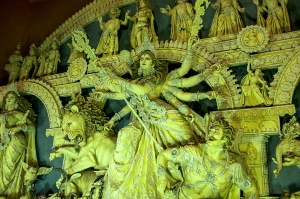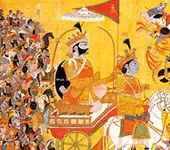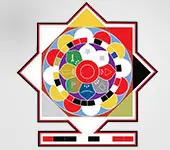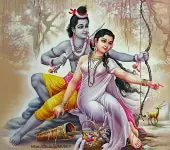Animal Sacrifice In Vedic Yajnas
Learn about the symbolism behind animal sacrifice in Vedic yajnas
Quiz
How many persons do you find in a Sri Rama Pattabhishekam picture?Transcript
(Click here to read more)
Many of the rituals in Vedic yajnas are very mystical. Unless you go deep into them at an esoteric level, they are very difficult to comprehend. Here, in Dasharatha's Ashwamedha yaga which he performed to beget children, the horse has already been sacrificed. The queen, Kausalya has spent the night with the body of the horse, performing various rituals. King Dasharatha and the main ritwiks who are conducting the yajna have also kept awake throughout the night. Now, in the next step, the king offers as dakshina his own four wives to the four main ritwiks, sym....
Transcript
(Click here)
Many of the rituals in Vedic yajnas are very mystical.
Unless you go deep into them at an esoteric level, they are very difficult to comprehend.
Here, in Dasharatha's Ashwamedha yaga which he performed to beget children, the horse has already been sacrificed.
The queen, Kausalya has spent the night with the body of the horse, performing various rituals.
King Dasharatha and the main ritwiks who are conducting the yajna have also kept awake throughout the night.
Now, in the next step, the king offers as dakshina his own four wives to the four main ritwiks, symbolically of course.
Like how you do pani grahana during the vedic wedding ritual.
The actual dakshina is in the form of gold or cows, this is just symbolic.
Vedic yajnas involve a lot of charity.
They are not relinquishing and walking away.
They are not like abandoning and walking away.
But, if you have to attain a higher world, you have to give up what all you that you presently have, right?
Dasharatha is aiming for a place in Swarga.
So, symbolically he will have to give up what all he presently has.
It is like crossing a bridge.
Unless you are ready to leave behind the land on this side, you will not be able to go to the other side.
But if you are just abandoning your family, that is very bad karma.
So, essentially by offering his own wives as dakshina to the ritwiks, he is handing over their responsibility to them.
Thereafter, they will take care of them as their husbands.
They will be responsible for their well being.
Even children are handed over as dakshina.
Don't you remember?
Nachiketas in Kathopanishad asked his father, 'who are you going to give me to?'
While performing these rituals, it is very important that the yajamana understands these concepts.
Dasharatha should understand all these.
If I have to go to swarga, then I have to leave behind everything, including my wives.
But it is also my responsibility to ensure that they are in safe hands, they are taken care of well.
Any king would have several wives.
Here the महिषी or the coronated queen is Kausalya.
She is offered as dakshina to Brahma
The coronated queen is called परिवृत्ति - she is given to Udgata.
Then there is वावाता who is given to Hota.
and पालाकली who is given to Adhwryu.
There are some so-called Indologists who say that the queen and other wives have to spend the night with the purohits.
Nothing else can be far from the truth.
This ritual happens the next day morning, not in the night.
And it is just symbolic.
The most important organ offered in Agni in any animal sacrifice is called वपा.
It is the skin that envelopes the abdomen called the omentum.
In fact, the horse doesn't have an omentum.
So, its तेजनी is used in its place.
The adhwaryu then cooks the vapa and offers it in agni.
The yajamana has to smell the smoke coming out while it is consumed by Agni.
This is a very important part in animal sacrifice.
This smoke has the power to relieve the yajamana of all his past sins.
धूमगन्धं वपायास्तु जिघ्रति स्म नराधिपः ।
यथाकालं यथान्यायं निर्णुदन्पापमात्मनः ॥
Next is angahoma.
All the remaining organs of the horse are offered Agni.
We have earlier seen that Kausalya herself had marked with three golden needles the lines through which the horse is to be cut to pieces.
This angahoma is done by sixteen ritwiks.
The entire horse is offered in agni.
No part is consumed by anyone.
The sins are present all over the body.
The horse by now should be clear is closely connected to the yajamana's terrestrial existence.
When all the organs of the horse are offered in agni that means, sins present in all the organs of the yajamana are also burned away.
This main concluding part of the Ashwamedha yaga has got three important days called the सवनीय days -
चतुष्टोम, उक्थand अतिरात्र.
All these were duly performed.
There are many versions of Ashwamedha.
King Dasharatha performed all the yajnas prescribed in all the versions.
Such as ज्योतिष्टोम, अभिजित्, विश्वजित्, आप्तोर्याम
They were all performed after the savaneeya days.
Now is the time to give dakshina.
We will see that in the next episode.
Recommended for you
Have you heard about Mangala Chandika Devi?
 Click here to know more..
Click here to know more..
When do a teacher and student become enemies of each other?
 Click here to know more..
Click here to know more..
Brihaspati Kavacham

asya shreebri'haspatikavachastotramantrasya. eeshvara ri'shih'. anusht'up chhandah'. gururdevataa. gam beejam. shreeshaktih'. kleem keelakam. gurupree....
Click here to know more..
English Topics
Ramayana
Click on any topic to open
- 50 Janaka's Spiritual Evolution - From Jnana to Bhakti
- 49 Dasharatha's Grief Decoded
- 48 Shiva burned Kamadeva at Chhapra, Bihar
- 47 Motherhood brilliance - Kausalya Supraja Rama
- 46 Bala and Atibala Mantras - Sriram Ji will unfold their superpower
- 45 Dasharatha Pleads With Vishwamtra Not To Take Away Young Sriram Ji
- 44 Abandoning Of Sita Devi - Is It Justifiable?
- 43 Vishwamitra Wants To Take Young Sriram Ji With Him
- 42 Position Of Sages In Ancient Bharata
- 41 Horoscope of Sriram Ji
Please wait while the audio list loads..
30
Ganapathy
Shiva
Hanuman
Devi
Vishnu Sahasranama
Mahabharatam
Practical Wisdom
Yoga Vasishta
Vedas
Rituals
Rare Topics
Devi Mahatmyam
Glory of Venkatesha
Shani Mahatmya
Story of Sri Yantra
Rudram Explained
Atharva Sheersha
Sri Suktam
Kathopanishad
Ramayana
Mystique
Mantra Shastra
Bharat Matha
Bhagavatam
Astrology
Temples
Spiritual books
Purana Stories
Festivals
Sages and Saints
